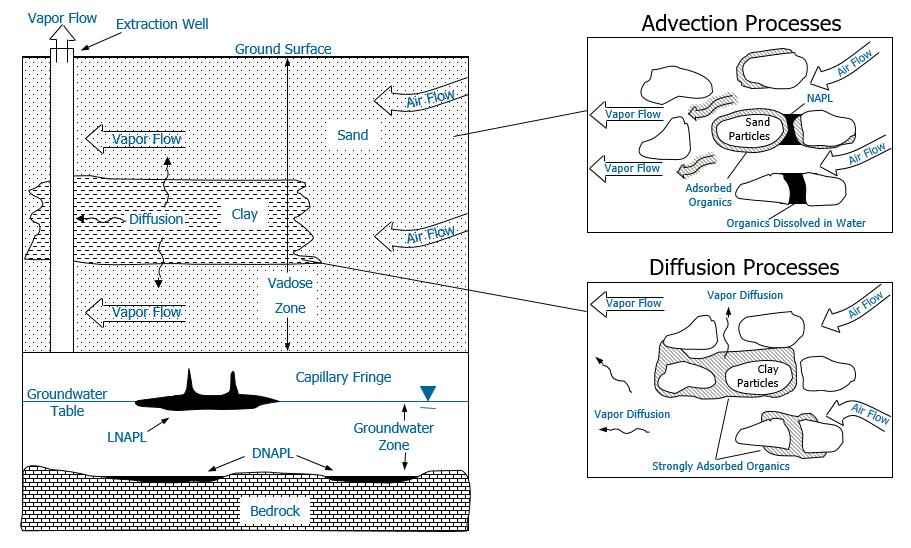Soil vapor extraction (SVE) is a mature in-situ remediation processes that can be effective at removing volatile organic compounds (VOCs) from impacted media in both the vadose zone. VOCs can be liquids within the soil pores, solutes in the soil moisture, adsorbed onto soil particles, and/or vapor in the pore space between soil particles.
Soil vapor extraction is often used as a stand alone remedy when VOCs are only impacting unsaturated soils. By applying a vacuum to vadose zone wells, air is drawn down from the atmosphere and through the soil column, enhancing volatilization. The captured vapors are drawn to the surface for treatment and discharge, as required.
Often, soil vapor extraction systems will be designed based upon vacuum distribution in the subsurface. As vacuum distribution does not specifically translate into the flow necessary for volatilization and transport to the surface, XDD uses both industry and proprietary models in our design process relative to pore-volume exchanges or soil gas velocities. XDD Environmental’s design process adds certainty relative to both remedy effectiveness and also the timeframe required to meet project goals, which can significantly impact the cost of the remedy
What chemicals are treated?
As a general rule, compounds with a vapor pressure of greater than 1 mm of mercury are potential candidates for air sparging and soil vapor extraction. Some compounds with high aqueous solubilities may be difficult to remedy with either of these technologies. Additionally, metals may be precipitated via the geochemical changes induced by the injection of air into the subsurface. The geochemical changes and metals precipitation may be a transient condition.
When to use soil vapor extraction?
SVE is generally a cost effective remedial technology for removing VOCs from soils. In general, cost is less sensitive to the total mass of VOCs than other technologies, such as enhanced biodegradation or in situ chemical oxidation. Additionally, soil vapor extraction can be installed and operated underneath buildings and other structures with little disruption. As SVE requires vapor flow through soil, lower permeability soils can reduce the cost effectiveness.
How long will it take?
Depending upon the design of the system, SVE can take anywhere from one to more than three years. It is important to understand the site conceptual model relative to the magnitude of impacts when trying to set achievable goals for this technology.
Design considerations
What are the contaminants and their properties? Where is the source?
Requires good understanding site geology:
- Variable geology may result in preferential treatment of higher-permeable soils, or poor treatment of low-permeability soils
- Can be negatively affected by highly variable groundwater table (i.e. sucks up water)
Generally pilot-tested to determine performance capabilities
- Injection/Extraction rates
- Radius of influence of each well location (determines the number and spacing of wells)
- Performance capabilities can be determined with relatively simple modeling using pilot testing results
Optimization
- Increase or decrease flow/vacuum at specific locations or areas to target specific location, areas, or interval
More information on XDD Environmental’s soil vapor extraction (SVE) experience and services.
Additional references:

